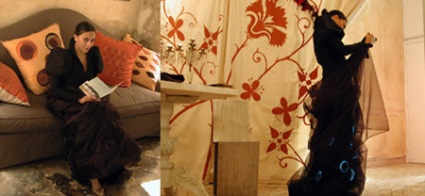Archive for August, 2007
Electroland turns an apartment-building facade into a billboard for pedestrian movement.
This project consists of a luminous field of LED lights embedded into the entry walkway that respond to the presence of visitors a massive display of lights on the building face that mirror the patterns of the entry and video displays in the lobby and entry areas.
To the designers at the Los Angeles–based firm Electroland, modern life is a video game.
“There’s a vast network of electronic information surrounding us, and we’re navigating and participating in it all the time.”
For that project, they mounted lights in 81 windows of the architecture school’s new home, a converted train depot, and anyone could illuminate them by calling a particular number on their mobiles and using their keypads to control the sequence of red, green, and blue.
The installation comprises two main elements. The first is an array of electronic tiles that sits just outside the entrance to the Met Lofts lobby, and serves as the interface with pedestrians. Electroland set a riser system into the surrounding concrete, then placed a grid of 176 16-inch-square tiles within it. Each tile is a sandwich of fritted glass and plastic that holds 96 red LEDs and has four compression sensors and a microcomputer on its underside. When someone steps on a tile, the sensors and microcomputer send data to a master computer located in the lobby. That computer in turn signals the tile to illuminate.
Besides feeding back to the tile array, the master computer links to EnterActive’s second major component: a grid of illuminated squares mounted on the building’s west elevation. While the facade display is more truncated than the sidewalk array, Electroland’s proprietary software translates the gameboard’s human movements and computerized patterns into supergraphics flashing on the side of the apartment building. Seeley says that players detect the correlation between themselves and the building face, and understand their influence on the urban landscape.
The system
The KineticDress is sewn of an elastic textile embedded with sensors that follows closely the body of the wearer. The sensors are able to capture the wearer’s movements and interaction with others and display this data through the electroluminescent embroidery that covers the external skirt section of the dress.
Depending on the amount and speed of the wearer’s movement the electroluminescent embroidery changes pattern, displaying the wearer’s mood to the audience and creating a magic halo around her.
The algorithmic program that controls the KineticDress is designed to follow the pace of the wearer: a still pose, when sitting alone shows a black dress, when the wearer starts moving and interacting with others the dress slowly lights up with a blue-circles pattern that moving creates a magic halo around the wearer.
Research
The KineticDress is part of the TransforMe collection developed for the NEMO Science Museum event ‘How Smart Are You Dressed Tomorrow?’ held in Amsterdam on November 6th 2004. The Transfor-Me collection was developed to demonstrate how the combination of interaction design and smart textiles can change the field of fashion design adding meaning and playfulness to commonly used garments such as skirts and dresses. Additionally transformable and interactive garments changing their appearance through the day or during any activity of the wearer stimulates personal interaction and communication.
With the lights on, it’s just a 50-lb. ball coated with white house paint. But in the dark, Science on a Sphere represents a new way of viewing the world. Developed by the National Oceanic and Atmospheric Administration, the technology, which uses four projectors, could initially beam only basic pictures of planets. But researchers at NASA figured out a way to use full-motion video to create a mind-bending, cinema-in-the-round experience. Their first effort is a 16-min. film, Footprints, which depicts spinning hurricanes and zooming cars.
The Earth is not flat.
That’s the conceptual spark for a new film created at the NASA Goddard Space Flight Center. Using an advanced media projection technology called Science On a Sphere developed by the National Oceanic and Atmospheric Administration (NOAA), FOOTPRINTS is the first fully produced film of its kind. The movie presents advanced satellite data and other visual effects on a dramatic spherical screen, affording viewers a chance to experience planets and planetary science in a way that’s more natural to their actual appearance. The Earth guest stars in a variety of guises, from depictions of the biosphere to planetary views of city lights at night to dramatic examinations about the science of hurricane formation. Other moons and planets make exciting cameos too, with special presentations of Mars and Earth’s moon. What’s more, the two agencies have announced that they’re releasing this new production to a consortium of science museums that already have Spheres on display. In ten U.S. cities this fall FOOTPRINTS will join other supporting Spheres on public exhibition.



